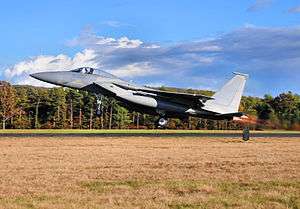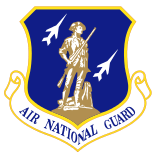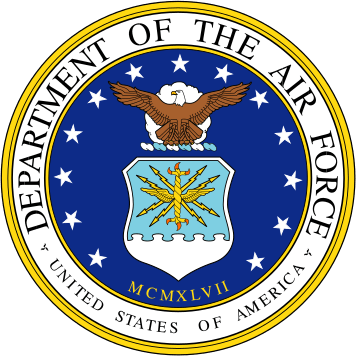104th Fighter Wing
| 104th Fighter Wing | |
|---|---|
|
104th Fighter Wing F-15C-38-MC Eagle 84-0016 | |
| Active | 1956–present |
| Country |
|
| Allegiance |
|
| Branch |
|
| Type | Wing |
| Role | Fighter/Air Defense |
| Size | 20 F-15C Eagles |
| Part of | Massachusetts Air National Guard |
| Garrison/HQ | Westfield-Barnes Regional Airport (Barnes ANGB), Westfield, Massachusetts |
| Nickname(s) | Barnestormers |
| Tail Code | "MA" Red tail stripe |
| Insignia | |
| 104th Fighter Wing emblem |
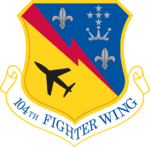 |
The 104th Fighter Wing (104 FW) is a unit of the Massachusetts Air National Guard, stationed at Westfield-Barnes Regional Airport (Barnes Air National Guard Base), Westfield, Massachusetts. If activated to federal service, the Wing is gained by the United States Air Force Air Combat Command.
As commonwealth militia units, the units in the 104th Fighter Wing are not in the normal United States Air Force chain of command. They are under the jurisdiction of the Massachusetts National Guard unless they are federalized by order of the President of the United States.
Overview
The 104th Fighter Wing supports Air Force wartime contingency requirements and performs a variety of peacetime missions required by the Air Force to include an active Air Sovereignty Alert presence and compatible mobilization readiness.
Specifically, the Wing is tasked to provide operationally ready combat units, combat support units and qualified personnel for active duty. Its goal is to organize, train and equip assigned personnel to provide an operationally ready squadron to the Air Combat Command that flies and fights successfully.
Units
The 104th Fighter Wing consists of the following major units:
- 104th Operations Group
- 104th Maintenance Group
- 104th Mission Support Group
- 104th Medical Group
History
On 1 May 1956 the Massachusetts Air National Guard 102d Fighter-Interceptor Wing was expanded and re-designated as the 102d Air Defense Wing. As a result, the 131st Fighter-Interceptor Squadron at Barnes Municipal Airport was authorized to expand to a group level, and the 104th Fighter Group (Air Defense) was established by the National Guard Bureau. The 131st FIS becoming the group's flying squadron. Other squadrons assigned into the group were the 104th Headquarters, 104th Material Squadron (Maintenance), 104th Combat Support Squadron, and the 104th USAF Dispensary.
The mission of the 104th Fighter Group was the air defense of Massachusetts. The 104th, along with the new 102d Fighter Group (Air Defense) at Logan Airport, Boston began attending annual training at Otis Air Force Base.
Tactical Air Command
The air defense mission ended on 10 November 1958 when the Massachusetts Air Guard and its units were reassigned to Tactical Air Command (TAC) and converted to F-86H Sabre fighter-bombers. During the 1950s and early 1960s, better training and equipment, and closer relations with the Air Force greatly improved the readiness of the Massachusetts Air National Guard.
1961 Berlin Federalization

During the summer of 1961, as the 1961 Berlin Crisis unfolded, the 131st TFS was notified on 16 August of its pending federalization and recall to active duty. On 1 October the 131st was federalized and assigned to the 102d Tactical Fighter Wing, which was federalized and placed on active duty at Otis Air Force Base.
The mission of the 102d TFW was to reinforce the United States Air Forces in Europe (USAFE) and deploy to Phalsbourg-Bourscheid Air Base, France. In France, the unit was to provide close air support to NATO ground forces and air interdiction. This involved keeping its aircraft on 24/7 alert. Between 28 and 30 October, the 102d TFW departed Otis AFB for Phalsbourg. The wing deployed 82 F-86H Sabres. In addition 2 C-47 and 6 T-33 aircraft were assigned to the wing for support and training purposes.
Starting on 5 December, the 102d began deploying to Wheelus Air Base Libya for gunnery training. During its time in Europe, the 102d participated in several USAF and NATO exercises, including a deployment to Leck Air Base, West Germany near the Danish border. At Leck, ground and support crews from both countries exchanged duties, learning how to perform aircraft maintenance and operational support tasks.
On 7 May 1962, USAFE Seventeenth Air Force directed that the 102d TFW would deploy back to the United States during the summer, and the unit returned to the United States in July 1962. Regular USAF personnel, along with a group of ANG personnel who volunteered to remain on active duty formed the 480th Tactical Fighter Squadron of the newly activated 366th Tactical Fighter Wing. The last of the ANG aircraft departing on 20 July.
Vietnam era

After the Berlin Crisis, the readiness status of the 104th Tactical Fighter Group greatly improved under the “gaining command concept”, whereby the U.S. Air Force Tactical Air Command was responsible for overseeing the training of the Group. Operational readiness inspections also honed the edges of the wing.
In 1964, the 131st TFS was switched from F-86H Sabres to the F-84F Thunderstreak. Exactly why this equipment change was made can not be determined. The F-86H was a viable aircraft in the ANG's inventory, with the Sabres from both the 101st and 131st TFS's being sent to the New Jersey ANG, and the 119th and 141st TFS's sending their F-84Fs to the Massachusetts squadrons. The 131st flew the Thunderstreaks throughout the 1960s, and although the squadron was not activated during the Vietnam War, several of its pilots volunteered for combat duty in Southeast Asia. In 1971, the 104th began re-equipping with the F-100D Super Sabre; the Air Guard was always one generation of fighter aircraft behind the Air Force during this time.
Close Air Support
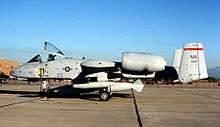
The 104th remained as a tactical fighter unit flying the F-100 until July 1979 when the F-100s were retired and the unit was re-equipped with new A-10 Thunderbolt IIs as part of the "Total Force" concept which equipped ANG units with front-line USAF aircraft. This marked the first time the 131st had received new aircraft.
For most of its existence, the Air Guard had been a reserve force for use only in wartime. By the 1980s, the Air Guard was an integral part of daily Air Force operations. As a result, the Massachusetts Air Guard took on more missions. With the receipt of the A-10, the 104th began a commitment to the United States Air Forces in Europe (USAFE), beginning frequent deployments to West Germany, England, Italy, Turkey, and other NATO bases.
As the Cold War was ending, the Massachusetts Air National Guard was called upon to meet new challenges. Iraq’s invasion of Kuwait in August 1990 led to a U.S. response with air, ground and naval attacks during Operation Desert Storm. While no flying units of the Massachusetts Air Guard were mobilized, mission support units provided personnel to backfill deploying Air Force units in the U.S. The Total Force Policy of the Department of Defense stipulated that the Reserve Components were to play a large role in the nation’s defense.
Air Combat Command
In March 1992, with the end of the Cold War, the 104th adopted the Air Force Objective Organization plan, and the unit was re-designated as the 104th Fighter Group. In June, Tactical Air Command was inactivated as part of the Air Force reorganization after the end of the Cold War. It was replaced by Air Combat Command (ACC). In 1995, in accordance with the Air Force "One Base-One Wing" directive, the 104th was changed in status back to a Wing, and the 131st Fighter Squadron was assigned to the new 104th Operations Group.
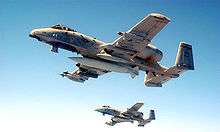
From August to October 1995, some 400 Airmen of the 104th Fighter Wing deployed to Aviano Air Base, Italy as part of the NATO mission to repel Serbian forces in Bosnia. This was the first time that the 131st Fighter Squadron flew combat sorties. Four years later, in 1999, elements of the 104th mobilized and flew sorties over the skies of the former Republic of Yugoslavia. As part of an Air Guard A-10 group, the 131st attacked Serb forces in Kosovo.
In mid-1996, the Air Force, in response to budget cuts, and changing world situations, began experimenting with Air Expeditionary organizations. The Air Expeditionary Force (AEF) concept was developed that would mix Active-Duty, Reserve and Air National Guard elements into a combined force. Instead of entire permanent units deploying as "Provisional" as in the 1991 Gulf War, Expeditionary units are composed of "aviation packages" from several wings, including active-duty Air Force, the Air Force Reserve Command and the Air National Guard, would be married together to carry out the assigned deployment rotation.
As a result of the Global War on Terrorism, in 2003, the 131st Expeditionary Fighter Squadron flew hundreds of combat missions with the A-10 in support of U.S. Army and Marine operations in Afghanistan (Operation Enduring Freedom) and Iraq (Operation Iraqi Freedom). During March and April 2003, as part of Operation Iraqi Freedom, 131st Fighter Squadron A-10s supported the U.S. Army by flying combat missions that interdicted enemy forces. The 104th played a major role with its air support.

In its 2005 BRAC Recommendations, DoD recommended to Barnes Municipal Airport Air Guard Station and send its A-10s to the Maryland Air National Guard 104th Fighter Squadron, Warfield Air National Guard Base, Middle River, Maryland. In return, the 104th received the F-15C/D Eagles of the 102d Fighter Wing at Otis Air National Guard Base, which was to convert into a non-flying Intelligence Wing. The realignment marked the end for the 104th's nearly 30-year mission of flying close-air support missions with the A-10. The 104th took over the homeland security mission of the 102d. In 2007, the A-10s began flying to Maryland and the F-15s began arriving from Otis ANGB. By the end of 2007, eighteen F-15C and a trainer F-15D arrived.
In addition to the air defense mission, the men and women of the 104th Fighter Wing deploy on Air Expeditionary missions to the Middle East in support of combat operations as part of Operation Enduring Freedom. The last such deployment was completed in July, 2012.
In May 2013, it was announced that one third of the 104th Fighter Wing's F-15 aircraft would be moving to Otis Air National Guard Base to take up an alert mission for four to six month, as Barnes' runway underwent renovation.[1][2]
On 27 August 2014, a jet from the wing crashed into the ground near Elliot Knob, Virginia just before nine in the morning.[3] The pilot had reportedly made an emergency call before the crash and was on its way to Naval Air Station Joint Reserve Base New Orleans.[4] Officials scoured George Washington National Forest in an attempt to find the pilot.[5] It was later revealed that the pilot was unable to eject from the aircraft and was killed instantly.[6]
Lineage
- Established as the 104th Fighter Group (Air Defense) and allotted to the Air National Guard on 15 April 1956
- Activated in the Massachusetts Air National Guard on 1 May 1956 and federally recognized
- Redesignated 104th Tactical Fighter Group on 10 November 1958
- Redesignated 104th Fighter Group on 15 March 1992
- Redesignated 104th Fighter Wing on 1 October 1995
Assignments
- 103d Air Defense Wing, 1 May 1956
- 102d Air Defense Wing (later 102d Tactical Fighter Wing), 1 July 1957
- 108th Tactical Fighter Wing, 1 June 1972
- 174th Tactical Fighter Wing, 1979
- 102 Fighter Wing, 1 June 1992
- Massachusetts Air National Guard, 1 October 1995
- Gaining Commands
- Air Defense Command, 1 May 1956
- Tactical Air Command, 10 November 1958
- Air Combat Command, 1 June 1992 - present
Components
- 104th Operations Group, 1 October 1995 – present
- 131st Fighter-Interceptor Squadron (later Tactical Fighter Squadron, Fighter Squadron), 1 May 1956 – 1 October 1995
Stations
- Barnes Municipal Airport (later Barnes Air National Guard Base), Massachusetts, 1 May 1956 – present
Aircraft
|
|
References
Notes
- ↑ Berry, Conor (29 May 2013). "Fighter jets from Barnes Air National Guard Base to move temporarily to Cape Cod base to accommodate repairs at Westfield base". Westfield, Massachusetts: Springfield Republican. Retrieved 29 May 2013.
- ↑ Brennan, George (29 May 2013). "F-15s returning to Cape base, for now". Falmouth, Massachusetts. Retrieved 29 May 2013.
- ↑ Bacon, John; Stanglin, Doug (27 August 2014). "F-15 fighter jet crashes in Virginia forest". USA Today. Retrieved 27 August 2014.
- ↑ Mai-Duc, Christine (27 August 2014). "Pilot made emergency call shortly before F-15 crashed in Virginia". Los Angeles Times. Retrieved 27 August 2014.
- ↑ Kinney, Jim (28 August 2014). "F-15 crash: Barnes officials expect updates from investigators at crash site". The Republican. Retrieved 29 August 2014.
- ↑ LeForge, Jeanette (7 September 2014). "Pilot in F-15 crash remembered as 'difference maker'". The News Leader. Retrieved 8 September 2014.
Bibliography
![]() This article incorporates public domain material from the Air Force Historical Research Agency website http://www.afhra.af.mil/.
This article incorporates public domain material from the Air Force Historical Research Agency website http://www.afhra.af.mil/.
- 104th Fighter Wing history
- Massachusetts ANG History
- 131st Fighter Squadron lineage and history
- Rogers, B. (2006). United States Air Force Unit Designations Since 1978. ISBN 1-85780-197-0
- McLaren, David. Republic F-84 Thunderjet, Thunderstreak & Thunderflash: A Photo Chronicle. Atglen, PA: Schiffer Military/Aviation History, 1998. ISBN 0-7643-0444-5.
